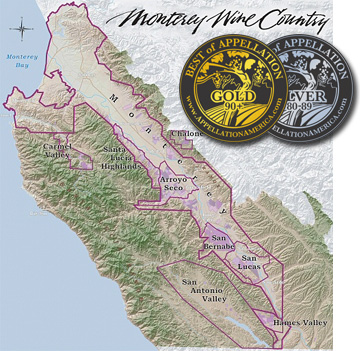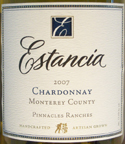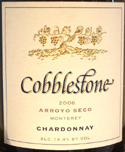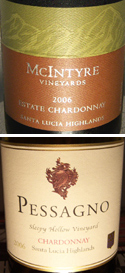 The diversity of the multiple sub-AVAs of Monterey County promise a wide range of varietals and wine qualities.
The diversity of the multiple sub-AVAs of Monterey County promise a wide range of varietals and wine qualities.Therein lies the region's innate strength.
The Appellation Defining Wines of the Monterey Region
A look at the whys and wherefores of the Best-of-Appellation™ Wines.
by Clark Smith
September 17, 2008
 t one level of conversation it is useful to talk about “Monterey” as a winegrowing region, just as, for example, we speak of “Bordeaux”. But to truly understand the many layers of virtue to be found in “Monterey” wines, it is necessary to map the diversity of the wines, which is inherent in the complex patchwork of terroirs and wine producing cultures spread across the county.
t one level of conversation it is useful to talk about “Monterey” as a winegrowing region, just as, for example, we speak of “Bordeaux”. But to truly understand the many layers of virtue to be found in “Monterey” wines, it is necessary to map the diversity of the wines, which is inherent in the complex patchwork of terroirs and wine producing cultures spread across the county.
including vineyard designations
Arroyo Seco (AVA)
Carmel Valley (AVA)
Chalone (AVA)
Hames Valley (AVA)
Monterey (AVA)
Monterey County appellation
San Antonio Valley (AVA)
San Bernabe (AVA)
San Lucas (AVA)
Santa Lucia Highlands (AVA)
As always, our method of evaluation is focused on identifying patterns of typicity, which mark both the wines and production technologies of each region. From this reference point, appellation-by-appellation, varietal-by-varietal, we pursue the proposition that:
and the character of each appellation is defined by its best wines.
Here, then, is the first round of findings in an on-going process of profiling the distinctive wine
characters of the Monterey appellations. The exemplary wines cited below are among those advanced to Best-of-Appellation™ standing.
-- Chardonnay --
 Monterey AVA: The standard profile for valley floor Chardonnay is a rich, straightforward apple / pear fruit aroma and jasmine floweriness without any citrus element, followed by a lush natural sweetness in the mouth offset by crisp acidity. These wines do not normally see wood or undergo malolactic fermentation. With extensive hangtime, a second variation emerges with lower acidity and aromas of marigold and orange.
Monterey AVA: The standard profile for valley floor Chardonnay is a rich, straightforward apple / pear fruit aroma and jasmine floweriness without any citrus element, followed by a lush natural sweetness in the mouth offset by crisp acidity. These wines do not normally see wood or undergo malolactic fermentation. With extensive hangtime, a second variation emerges with lower acidity and aromas of marigold and orange. * Carmel Road, 2006 Chardonnay
* Estancia, 2007 Chardonnay
* Jekel, 2006 Chardonnay
Arroyo Seco AVA: Here we found two distinct profiles. The “Ripe & Fruity” style embraces the region’s instantly recognizable ripe nectarine aroma and guava / stone fruit features in the mouth through restrained oak and minimal intervention. Sometimes a buttery finish contributes a variation which plays appealingly with the stone fruit flavors. Grown mostly on the exposed alluvial fan on the east side of the AVA,
 they owe their racy acidity and natural sweetness to the daily cooling winds from the north, and achieve generosity from their rocky sub-soils and relatively southerly location.
they owe their racy acidity and natural sweetness to the daily cooling winds from the north, and achieve generosity from their rocky sub-soils and relatively southerly location. * Carmel Road, 2006 Chardonnay (Clark Ranch)
* J. Johr, 2006 “October Night” Chardonnay
In the alternate profile, these traits are suppressed in an effort to make a more serious wine, exactly as in expensive white Bordeaux, and techniques such as assertive wood, prolonged barrel ageing and extensive lees stirring produce a Meursault custard impression resting on integrated, complex flavors.
* Cobblestone, 2006 Chardonnay (Estate)
Chalone AVA: Utterly distinctive, and without any of the natural sweetness or ripe fruit of the valley floor Chardonnays. Intense grapefruit aromas typical of high altitude and lean but assertive ripe pineapple flavors, charged with intense minerality from limestone and from minimum tillage living soil practices. Because of their energy, these wines often require extensive age to mature and may exhibit excessive reductive strength when young.
Santa Lucia Highlands AVA: It is difficult to describe the allure of these Chardonnays. Unlike their valley floor neighbors, they are not lush or oversized in
 any way, and this hollowness gives rise to a potential for alcoholic imbalance. Yet you put them in your mouth and you know you are in the presence of something that is all about class. The complex yet ethereal aromatics found here and nowhere else can be summed up in a word – rum. Other descriptors include molasses, lemon peel, ginger, jasmine and fig, usually accompanied by ample, well integrated oak, since one to two years’ barrel ageing is essential to development. The mouth is characteristically austere and hollow, often with a trace of heat, and the finish contains a mineral intensity, which somehow marries delicacy and power.
any way, and this hollowness gives rise to a potential for alcoholic imbalance. Yet you put them in your mouth and you know you are in the presence of something that is all about class. The complex yet ethereal aromatics found here and nowhere else can be summed up in a word – rum. Other descriptors include molasses, lemon peel, ginger, jasmine and fig, usually accompanied by ample, well integrated oak, since one to two years’ barrel ageing is essential to development. The mouth is characteristically austere and hollow, often with a trace of heat, and the finish contains a mineral intensity, which somehow marries delicacy and power. * Downhill Winery, 2006 Chardonnay
* Manzoni, 2005 Chardonnay (Estate)
* McIntyre, 2006 Chardonnay (Estate)
* Morgan, 2006 Chardonnay (Double L Vineyard)
* Paraiso, 2005 Chardonnay (Eagles' Perch Vineyard)
* Pessagno, 2006 Chardonnay (Sleepy Hollow Vineyard)
* Pessagno, 2006 Chardonnay (Intrinity Vineyard)
 READER FEEDBACK: To post your comments on this story,
click here
READER FEEDBACK: To post your comments on this story,
click here
Print this article |
Email this article |
More about Monterey |
More from Clark Smith
 READER FEEDBACK: To post your comments on this story,
click here
READER FEEDBACK: To post your comments on this story,
click here
Print this article | Email this article | More about Monterey | More from Clark Smith










